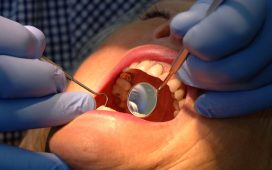Whether it’s everyday habits or seemingly harmless routines, certain activities can put your health at risk in the most unsuspecting ways.
In the heart of the hospital, emergency physicians are no strangers to chaos, as hundreds of patients walk through their doors each and every day.
Emergency rooms across the United States experience nearly 140 million visits each year, with countless patients arriving with everything from minor colds to life-threatening injuries, according to the CDC.
The national average of ER visits, the CDC reported, is 42 out of every 100 people. Around 30 percent of those visits are related to injures and roughly 63 percent of those patients are between the ages of 18 and 65.
‘We see the worst of the worst, and the silliest of the silliest,’ Abdullah Pratt, an emergency medicine physician at the University of Chicago Medicine, told The New York Times.
Interestingly enough, an incredible 85 percent of these patients reside in metropolitan areas.
As emergency rooms across the nation are constantly filled to capacity, it’s safe to say that ER doctors have seen it all – so much so that many of them have gone on to change their own personal behaviors throughout their careers.
Several emergency physicians across the country revealed the shocking truth behind six ‘normal’ activities that you should stop doing before it’s too late – warning that you could be at risk without ever even knowing it.
Don’t Wear Crocs in the Snow

While Crocs have gained popularity among Gen Z in recent years, ER doctors warn that their comfort and customizable designs may not be worth it – especially in the winter months

Abdullah Pratt, an emergency medicine physician at the University of Chicago Medicine is just one physician that won’t risk an injury for a quick errand, as he revealed that he sees ‘croc-specific injuries’ at least once a week throughout the cold seasons
While Crocs have gained popularity among Gen Z in recent years, ER doctors warn that their comfort and customizable designs may not be worth it – especially in the winter months.
Despite their ease and appeal, the unique lightweight shoes are far from safe when snowy or icy weather hit.
Dr. Pratt is just one physician that won’t risk an injury for a quick errand, as he revealed that he sees ‘croc-specific injuries’ at least once a week throughout the cold seasons.
‘The shoes don’t provide traction, and they don’t provide ankle support,’ he told the NYT. ‘People go flying, and so do their Crocs.’
There were a shocking 140 new claims for Croc-related injuries from 2018 to 2022, with the total cost of active claims across the five-year span reaching nearly $180,000, according to 1 News.
‘The shoes may not be dangerous on their own, it’s how people are wearing them really,’ James Whitaker, an ACC injury prevention expert, told the outlet.
The slippery soles are a recipe for disaster, causing slips, falls and potentially serious, sudden injuries. While they may be easy on your feet, those working in the chaos of the healthcare industry strongly recommend keeping them around as an indoor shoe.
Don’t Rush While Slicing Avocados

Avocados are surprisingly a main culprit for knife-related injuries – an injury an emergency physician based in Boston says is among the most frequent health issues she sees each year

Adaira Landry, an ER physician at Harvard Medical School-affiliated Brigham and Women’s hospital, said that she will often guess that these patients hurt themselves while slicing an avocado once they come in for treatment, as these injuries are so common

Matt Shannon, the director of community emergency medicine at University of Florida Health, divulged the safest way to avoid a bloody trip to the ER – use a secure, nonskid surface, such as a wooden cutting board, while cutting away from your body

Aside from avocados, Gregory Sugalski, the acting chair of the emergency department at Hackensack University Medical Center in New Jersey, said that there is another culprit in the kitchen for knife injuries – bagels
Avocados are a staple in the kitchen, as they are a healthy addition to tacos, salads and of course the beloved breakfast option – avocado toast.
Yet the popular fruit is surprisingly a main culprit for knife-related injuries – an injury an emergency physician based in Boston says is among the most frequent health issues she sees each year.
An estimated 350,000 people across the US head to the emergency room each year with knife-related injuries alone, according to Midwest Orthopaedics At Rush.
Adaira Landry, an ER physician at Harvard Medical School-affiliated Brigham and Women’s hospital, said that she will often guess that these patients hurt themselves while slicing an avocado once they come in for treatment, as these injuries are so common.
‘And they’re like: “Yes! How did you know?”‘ Landry said in reference to their response.
Aside from avocados, Gregory Sugalski, the acting chair of the emergency department at Hackensack University Medical Center in New Jersey, said that there is another culprit in the kitchen for knife injuries – bagels.
Sugalski told the NYT that he frequently sees patients that had ‘sliced their hands slicing bagels.’
Matt Shannon, the director of community emergency medicine at University of Florida Health, divulged the safest way to avoid a bloody trip to the ER – use a secure, nonskid surface, such as a wooden cutting board, while cutting away from your body.
‘Never cut toward your hand,’ he added.
Never Trust the Joys of a Trampoline

While many see trampolines as a joyous way to burn off some energy, ER doctors see the bouncy piece of equipment as a ‘broken-bone factory’

Dr. Sugalski said that he sees ‘fractures, dislocations, spinal injuries, head injuries all the time’ from trampolines

If you aren’t ready to part ways with the trampoline, ER doctors suggest jumping one at a time, as a majority of trampoline injuries happen when several people are jumping together
While many see trampolines as a joyous way to burn off some energy, ER doctors see the bouncy piece of equipment as a ‘broken-bone factory.’
‘We see fractures, dislocations, spinal injuries, head injuries all the time,’ Dr. Sugalski told the NYT.
According to a 2022 National Library of Medicine study, more than 800,000 trampoline-related injuries were reported between 2009 and 2018.
More than half of the injuries occurred when patients were leaping around a trampoline while at their own homes. The remaining percentage occurred at sporting venue-type places.
Shockingly, teenagers and girls are at increased risk of these injuries, many times warranting a dreadful trip to the hospital.
Sugalski, a father-of-three, immediately becomes uneasy when one of his children are invited to a birthday party, as trampolines are a popular past-time at dozens of children’s events.
‘When I hear “trampoline,” I’m like “Ugh, can we not go to this birthday party?”‘ Sugalski said.
If you aren’t ready to part ways with the trampoline, ER doctors suggest jumping one at a time, as a majority of trampoline injuries happen when several people are jumping together.
Making sure the trampoline is equipped with proper padding around the surrounding springs and bars is also an important factor, as it discourages somersalts and flips which commonly lead to permanent spinal and musculoskeletal injuries.
So before you take the leap, remember – what seems like fun could easily land you right inside the walls of the ER.
Strange Dogs Are Not Your Friend

After treating dozens of canine attack victims throughout his career, Dr. Pratt warned against petting unfamiliar dogs, noting how ‘you don’t know what kind of trauma that animal has been put through and what kind of triggers it has’

An estimated 4.7 million dog bites occur across the nation annually, with more than 333,000 victims having to be treated at an emergency department and most injuries being inflicted by family pets rather than strays
It’s no surprise that the world is filled with dog lovers who consider the highlight of their day scratching the heads of neighborhood pups.
Yet after treating dozens of canine attack victims throughout his career, Dr. Pratt warned against doing just that – petting unfamiliar dogs.
‘You don’t know what kind of trauma that animal has been put through and what kind of triggers it has,’ he told the NYT.
Even though his own children are ‘obsessed with dogs’, Dr. Sugalski makes sure they steer clear from approaching them – instead urging them to say ‘hi from a distance.’
‘You never know,’ he said.
Dog bites account for a whopping 85 percent of all animal bites that require medical attention, National Institutes of Health reported.
An estimated 4.7million dog bites occur across the nation annually, with more than 333,000 victims having to be treated at an emergency department.
Most of these injuries are inflicted by family pets rather than strays. The Insurance Information Institute estimates the healthcare cost for dog bites alone to reach beyond $300million in claims each year.
Whether its a complete stranger’s dog or a friendly neighbor’s, ER doctors recommend to avoid approaching them at all.
‘I think most dog owners have never seen what it looks like for a dog to maul someone,’ Dr. Pratt told the NYT. ‘I have.’
Don’t Brush Off Sudden Symptoms

When it comes to sudden, severe symptoms, several emergency physicians revealed that time is of the essence, and ignoring them could be a deadly mistake

Michael E. Silverman, the vice chairman of the department of emergency medicine at Morristown Medical Center in New Jersey, said that from his experience, driving yourself to the hospital during a health crisis only leads to more accidents and injuries

Though health anxiety is real, ER doctors stress the importance of taking unexpected and extreme symptoms seriously, whether it be chest pain, shortness of breath or paralysis of a body part
When it comes to sudden, severe symptoms, several emergency physicians revealed that time is of the essence, and ignoring them could be a deadly mistake.
Though health anxiety is real, ER doctors stress the importance of taking unexpected and extreme symptoms seriously, whether it be chest pain, shortness of breath or paralysis of a body part.
‘I understand that there’s going to be medical costs and the time in the emergency room, but those shouldn’t preclude you from saving your own life,’ Dr. Landry told the NYT.
As a worker in the healthcare industry, Dr. Landry doesn’t mess around with her own health. If any severe symptoms suddenly come on, she said, going to the emergency room immediately is the best course of action.
Those who experience symptoms closely aligned to a heart attack or a stroke should indeed go to the ER, but should avoid driving themselves at all costs.
Michael E. Silverman, the vice chairman of the department of emergency medicine at Morristown Medical Center in New Jersey, said that from his experience, driving yourself to the hospital during a health crisis only leads to more accidents and injuries.
Paramedics are equipped with defibrillators, he added, which can alert the hospital to prep a cardiac team – overall saving valuable time when all is said and done.
Moral of the story – trust your gut and don’t risk driving yourself to receive treatment. Prompt medical attention could be the difference between life and death.
Don’t Forget A Helmet

Ditching the helmet is a serious gamble that can quickly lead to life-altering consequences, whether that be for sports, e-bikes, motorcycles or a peaceful bicycle ride through the park

According to the National Institute of Health, around 80,000 cycling-related head injuries are treated in emergency rooms each year in the United States

Dr. Sugalski, who divulged that he always wears one, said that those dressed in the protective gear have a much greater chance at completely healing from possible injuries, adding that ‘for the most part, you’re walking away’
Graduating from helmets, knee-pads and training wheels to a two-wheeler bicycle is a milestone for hundreds across the country.
Yet ditching the helmet is a serious gamble that can quickly lead to life-altering consequences.
If that isn’t convincing enough, take into consideration that many emergency physicians still wear their helmets, whether it be for sports, e-bikes, motorcycles or a peaceful bicycle ride through the park.
‘You’re just looking for serious injury,’ Dr. Sugalski said to the NYT regarding those who fail to strap the piece of protection on.
‘We see folks come in with helmets and without helmets, and it’s night and day.’
According to the National Institute of Health, around 80,000 cycling-related head injuries are treated in emergency rooms each year in the United States. A significant portion of these injuries occur when the patient failed to wear a helmet.
For example, the use of bike helmets have been proven to greatly reduce the risk of severe head injury.
Dr. Sugalski, who divulged that he always wears one, said that those dressed in the protective gear have a much greater chance at completely healing from possible injuries, adding that ‘for the most part, you’re walking away.’














